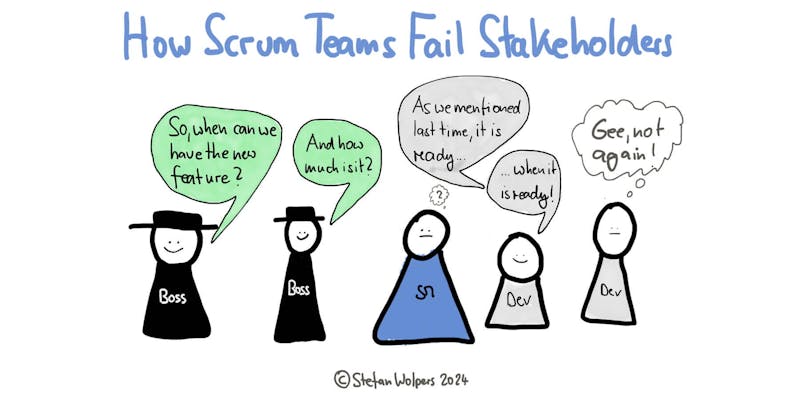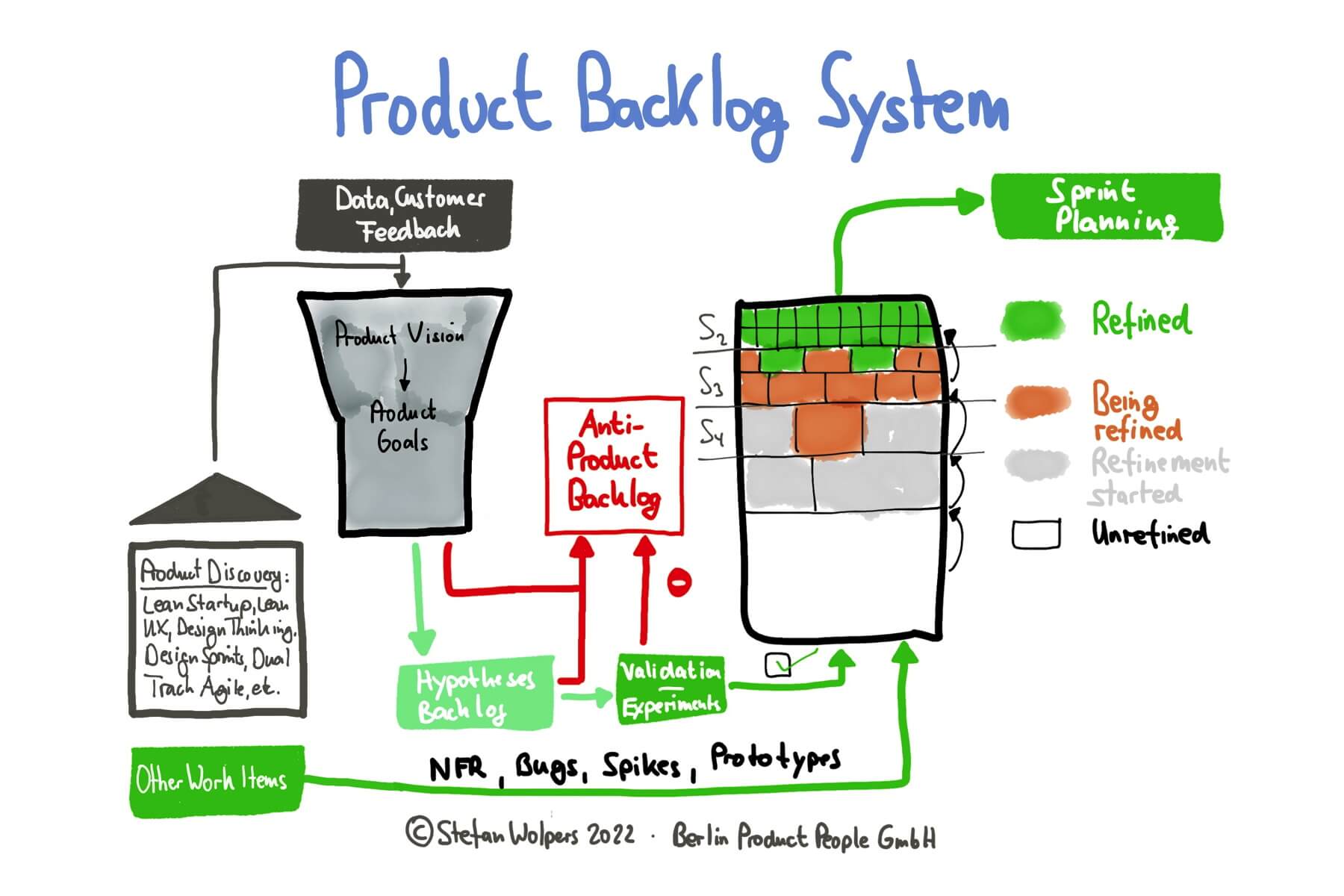|
In this article, we uncover typical ways in which Scrum teams fail stakeholders, from overpromising results to poor risk communication to neglecting feedback. Moreover, we will also explore actionable strategies to overcome these anti-patterns by building trust, aligning priorities, and enhancing collaboration for successful product development. (Read online.)

The most popular discussion on LinkedIn last week was: Your team’s success depends on the Product Backlog — don’t kill it!

🎓 May 30, 2024: Step into Expertise: Secure Your Spot in Advanced Product Backlog Management Course for Just $149!
9 Anti-Patterns of How Scrum Teams Fail Stakeholders
The following list aims to provide Scrum teams with a clear understanding of common mistakes in stakeholder interactions and practical advice for improving these relationships to achieve better outcomes and stronger collaboration:
- Over-promising and Under-Delivering:
-
Manifestation: Teams commit to more work than can realistically be completed within a Sprint, leading to unmet stakeholder expectations.
-
Stakeholder Perspective: Stakeholders depend on the Scrum team’s commitments to plan their activities and set expectations for their clients and superiors. When teams overpromise and underdeliver, it disrupts these plans. It erodes the trust and reliability placed in the team, as stakeholders will likely face negative feedback, possibly affecting their career perspectives if they continue to fail to deliver despite being dependent on other teams for the delivery. The responsibility for the failure will be theirs.
-
First Step: Initiate a thorough review of the team’s capacity and delivery capabilities to improve their future planning. While no one expects “precise forecasts,” a reasonable confidence in forecasts is expected. Engage in transparent discussions with stakeholders about what is realistically achievable, considering current bandwidth, skills, and potential obstacles. This approach fosters trust through honesty and realistic planning.
Insufficient Stakeholder Engagement:
-
Manifestation: Scrum teams fail to involve stakeholders adequately in the development process, especially during Sprint Reviews.
-
Stakeholder Perspective: Effective engagement ensures that stakeholders are informed and have a voice in the development process. Insufficient engagement leaves them feeling sidelined, questioning the relevance and alignment of the teams’ efforts’ outcomes with their actual needs, potentially leading to decreased support or questioning the usefulness of Scrum itself. (Please note: We are not paid to practice Scrum but to solve our customers’ problems within the given constraints while contributing to the organization’s sustainability.)
-
First Step: Establish a structured engagement plan beyond the invitation to standard Sprint Review sessions, outlining regular touchpoints and feedback sessions with stakeholders. It should prioritize inclusivity and active solicitation of input to ensure that stakeholder needs and expectations are continuously integrated into the team’s workflow. An excellent practice in this regard is, for example, collaborative User Story Mapping sessions. Learn more about Stakeholder communication here.
Poor Communication of Risks and Issues:
-
Manifestation: Teams avoid discussing potential risks and issues with stakeholders, hoping to resolve them internally.
-
Stakeholder Perspective: Scrum’s promise of transparency means stakeholders expect to be informed about potential risks and issues, making it a superior way of risk mitigation. However, concealing these realities can lead to unexpected turns of events, making stakeholders feel misled and questioning the team’s integrity and ability to manage challenges proactively. Also, communication failures may directly affect stakeholder’s career prospects, particularly regarding essential projects or products.
-
First Step: Develop a risk communication strategy that includes regular updates on potential issues and their mitigation plans. This strategy should aim for openness and collaborative problem-solving, inviting stakeholders to contribute their insights and support, thereby reinforcing a partnership built on mutual trust and respect. Engaging Sprint Review sessions and regular joint stakeholder/Scrum team Retrospectives are good starts. Learn more about Stakeholder Retrospectives here.
Ignoring Stakeholder Feedback:
-
Manifestation: Scrum teams fail to incorporate or adequately address feedback provided by stakeholders during or after Sprint Reviews.
-
Stakeholder Perspective: Stakeholders provide feedback based on their expertise, experience, and understanding of customer needs. Ignoring this valuable input can lead to outcomes that are misaligned with market demands or business goals, diminishing the perceived value of the Scrum team’s work.
-
First Step: Create a feedback loop mechanism to capture, evaluate, and address all stakeholder feedback appropriately. This mechanism should include transparent communication about how feedback is being incorporated or why specific suggestions cannot be implemented, maintaining an environment of mutual respect and understanding. An excellent tool for this purpose is a transparent system that funnels feedback, suggestions, or requirements into a Scrum team’s Product Backlog, as outlined in the following graphic.

Lack of Visibility into Progress:
-
Manifestation: Scrum teams fail to provide clear and understandable updates on progress toward the current Product Goal, leaving stakeholders in the dark and adding to the general uncertainty of a complex environment.
-
Stakeholder Perspective: Regular updates on progress are crucial for stakeholders to feel confident in the team’s direction and achievements. Lack of visibility can create uncertainty and anxiety, undermining confidence in the team’s ability to deliver and reducing stakeholders’ ability to support and advocate for the project.
-
First Step: Use tools and dashboards to provide real-time, transparent insights into the team’s progress and challenges. Ensure these tools are accessible and understandable to non-technical stakeholders, enabling them to track developments closely and feel reassured about a team’s progress toward its Product Goal. Besides dedicated information radiators tailored to the information needs of stakeholders, a team can employ additional tactics, such as access to its Product Backlog, possibly (unanimous) invitations to Daily Scrum sessions, creating good old reports and internal newsletters, or a team diary in the form of a blog, a Confluence page, or even a GitHub repository.
Misaligned Priorities:
-
Manifestation: Scrum teams prioritize work based on their perceptions rather than stakeholder or business value, leading to misaligned outcomes.
-
Stakeholder Perspective: Stakeholders expect the team to focus on delivering the highest business and customer value. When priorities are misaligned, it signals a disconnect between the team’s activities and the broader organizational goals, leading to frustration and questioning of the team’s strategic alignment. Moreover, the misalignment may result in diminished support for a Scrum team, potentially leading to defunding.
-
First Step: Facilitate a priority alignment workshop with key stakeholders to understand their vision, objectives, and expectations. Use this understanding to guide the creation of a Scrum team’s Product Goal, Product Backlog, and, consequently, future Sprint Planning sessions, ensuring that the team’s efforts directly contribute to achieving strategic goals. Excellent supportive tools for this purpose are visualization tools like the Product Strategy Canvas, the Business Model Canvas, or the Product Goal Canvas. Learn more about the effectiveness of these tools here.
Failure to Set Expectations:
-
Manifestation: Scrum teams do not clearly define or communicate what is achievable within a Sprint, setting unrealistic expectations.
-
Stakeholder Perspective: Clear expectations around Sprint Goals are fundamental for stakeholder satisfaction. Failure to set these expectations can lead to disappointment and the perception that the team is not delivering value, impacting the team’s reputation and stakeholder trust and potentially leading to more supervision and micromanagement from stakeholders, for example, in the form of imposed deadlines.
-
First Step: Invest in alignment of stakeholders and the Scrum team on the business objectives. Help the Scrum team understand what is most desirable from the organization’s and the customer’s perspective. At the same time, as a team, help the stakeholders understand, non-technical ones included, what is technically feasible in what time frame. Help them also understand what changes the team would need to make regarding, for example, skills, team composition, tools, or architecture to narrow the gap between stakeholder ambitions and a realistic delivery.
Neglecting Non-Technical Stakeholders:
-
Manifestation: Scrum Teams focus solely on technical aspects and fail to engage with stakeholders on business or user experience concerns.
-
Stakeholder Perspective: All stakeholders, regardless of their technical expertise, have a vested interest in the project’s success. Neglecting non-technical stakeholders can lead to a lack of buy-in and support, as they may feel their contributions or concerns are not being considered or valued. This perception of rejection may lead to reduced support for the team in the long run, possibly lobbying against the team itself.
-
First Step: Organize educational sessions for non-technical stakeholders to demystify the development process and facilitate their meaningful participation. Additionally, tailor communication and updates to be inclusive and accessible, ensuring all stakeholders can engage effectively with the team and its work. Moreover, as a preparatory means on the side of the Scrum team, engage in understanding your team’s stakeholder landscape: who do you need to keep close to what extent to secure the team’s future?
Inadequate Stakeholder Education:
-
Manifestation: Teams assume stakeholders understand agile product development in general and the Scrum processes and their roles in particular, leading to confusion and misalignment.
-
Stakeholder Perspective: A fundamental understanding of Scrum enables stakeholders to participate in and support the agile process effectively. Without this understanding, there’s a risk of misalignment and frustration, as stakeholders may not grasp the importance of their role in supporting the Scrum team, product success, or the rationale behind team decisions.
-
First Step: Develop and deliver a tailored educational program for stakeholders, covering key Scrum principles and practices and their expected roles and contributions. You can create an effective program even for stakeholders who are completely uneducated in the art of developing new products. Learn more about a Successful stakeholder educational program here: App Prototyping with Absolute Beginners – Creating a Shared Understanding of How Empiricism Works.
Food for Thought
Is there more that we should know about how Scrum teams fail stakeholders? Consider the following thoughts:
- How can Scrum teams balance stakeholder expectations and realistic delivery capabilities?
- In what ways can continuous stakeholder education transform the effectiveness of Scrum processes? Moreover, how do stakeholders have to educate Scrum teams to improve alignment?
- How do transparent risk communication and stakeholder feedback incorporation — or the lack thereof — impact the long-term relationship between Scrum teams and stakeholders?
Conclusion
Successful Scrum implementation hinges not just on following processes but on fostering deep, trust-based relationships with stakeholders. Addressing common pitfalls such as overpromising, insufficient engagement, and lack of visibility is crucial. By prioritizing clear communication, stakeholder education, and alignment on priorities, Scrum teams can ensure their efforts resonate well with stakeholder needs and organizational goals, ultimately leading to a more supportive, collaborative, and effective product development environment.
How does your team improve collaboration with stakeholders? Please share your experience with us in the comments.
📖 How Scrum Teams Fail Stakeholders — Related Posts
Scrum: 20 Sprint Planning Anti-Patterns
Daily Scrum Anti-Patterns: 24+2 Ways to Improve as a Scrum Team
15 Sprint Review Anti-Patterns Holding Back Scrum Teams
21 Sprint Retrospective Anti-Patterns Impeding Scrum Teams
Download the Scrum Anti-Patterns Guide for free.
📅 Training Classes, Meetups & Events
Upcoming classes and events:
See all upcoming classes here.

If you have friends or colleagues who might be interested in this article as well, please forward this email—it would mean the world to me!
Have a great day!
Best,
|


